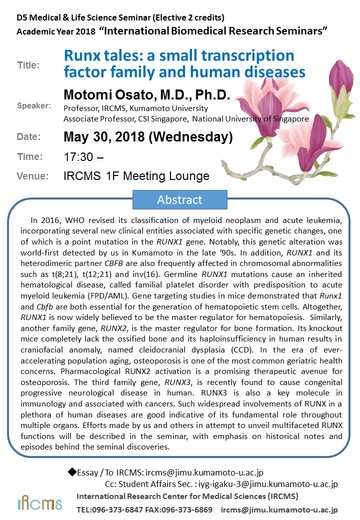- HOME
- News & Events
- [May 30]*D5 Medical & Life Science Seminar*
News & Events
[May 30]*D5 Medical & Life Science Seminar*
May 15 2018
The "D5 Medical & Life Science Seminar" course will be offered by International Research Center for Medical Sciences (IRCMS). It will run from May 2018 to March 2019, with lectures given by scientists affiliated or collaborated with the IRCMS. The course theme for this academic year is "Basic research for understanding disease mechanisms". The lectures will be given once a month, in English, and by leading scientists in the relevant research field. Students will be taught: 1) how normal physiological functions are maintained in human hematopoietic, vascular, immune, reproductive and nervous tissues and organs; 2) how abnormalities in these systems (e.g., cancer) are studied using experimental models; 3) cutting-edge technologies (including single cell level imaging and omics analysis) used for mechanistic understanding of these abnormalities; 4) efforts and progresses in finding cure for human diseases associated with these abnormalities; and 5) importance of understanding disease mechanisms using
Date: May 30, 2018 (Wed)
Time: 17:30 -
Venue: IRCMS 1F Meeting Lounge
Speaker: Motomi Osato, M.D., Ph.D.
Abstract:
In 2016, WHO revised its classification of myeloid neoplasm and acute leukemia, incorporating several new clinical entities associated with specific genetic changes, one of which is a point mutation in the RUNX1 gene. Notably, this genetic alteration was world-first detected by us in Kumamoto in the late '90s. In addition, RUNX1 and its heterodimeric partner CBFB are also frequently affected in chromosomal abnormalities such as t(8;21), t(12;21) and inv(16). Germline RUNX1 mutations cause an inherited hematological disease, called familial platelet disorder with predisposition to acute myeloid leukemia (FPD/AML). Gene targeting studies in mice demonstrated that Runx1 and Cbfb are both essential for the generation of hematopoietic stem cells. Altogether, RUNX1 is now widely believed to be the master regulator for hematopoiesis. Similarly, another family gene, RUNX2, is the master regulator for bone formation. Its knockout mice completely lack the ossified bone and its haploinsufficiency in human results in craniofacial anomaly, named cleidocranial dysplasia (CCD). In the era of ever-accelerating population aging, osteoporosis is one of the most common geriatric health concerns. Pharmacological RUNX2 activation is a promising therapeutic avenue for osteoporosis. The third family gene, RUNX3, is recently found to cause congenital progressive neurological disease in human. RUNX3 is also a key molecule in immunology and associated with cancers. Such widespread involvements of RUNX in a plethora of human diseases are good indicative of its fundamental role throughout multiple organs. Efforts made by us and others in attempt to unveil multifaceted RUNX functions will be described in the seminar, with emphasis on historical notes and episodes behind the seminal discoveries.

